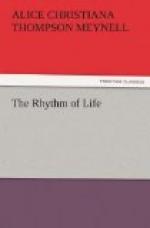To most of the great poets no greater praise can be given than praise of their imagery. Imagery is the natural language of their poetry. Without a parable she hardly speaks. But undoubtedly there is now and then a poet who touches the thing, not its likeness, too vitally, too sensitively, for even such a pause as the verse makes for love of the beautiful image. Those rare moments are simple, and their simplicity makes one of the reader’s keenest experiences. Other simplicities may be achieved by lesser art, but this is transcendent simplicity. There is nothing in the world more costly. It vouches for the beauty which it transcends; it answer for the riches it forbears; it implies the art which it fulfils. All abundance ministers to it, though it is so single. And here we get the sacrificial quality which is the well-kept secret of art at this perfection. All the faculties of the poet are used for preparing this naked greatness—are used and fruitfully spent and shed. The loveliness that stands and waits on the simplicity of certain of Mr. Coventry Patmore’s Odes, the fervours and splendours that are there, only to be put to silence—to silence of a kind that would be impossible were they less glorious—are testimonies to the difference between sacrifice and waste.
But does it seem less than reasonable to begin a review of a poet’s work with praise of an infrequent mood? Infrequent such a mood must needs be, yet it is in a profound sense characteristic. To have attained it once or twice is to have proved such gift and grace as a true history of literature would show to be above price, even gauged by the rude measure of rarity. Transcendent simplicity could not possibly be habitual. Man lives within garments and veils, and art is chiefly concerned with making mysteries of these for the loveliness of his life; when they are rent asunder it is impossible not to be aware that an overwhelming human emotion has been in action. Thus Departure, If I were Dead, A Farewell, Eurydice, The Toys, St. Valentine’s Day—though here there is in the exquisite imaginative play a mitigation of the bare vitality of feeling—group themselves apart as the innermost of the poet’s achievements.
Second to these come the Odes that have splendid thought in great images, and display—rather than, as do the poems first glanced at, betray—the beauties of poetic art. Emotion is here, too, and in shocks and throes, never frantic when almost intolerable. It is mortal pathos. If any other poet has filled a cup with a draught so unalloyed, we do not know it. Love and sorrow are pure in The Unknown Eros; and its author has not refused even the cup of terror. Against love often, against sorrow nearly always, against fear always, men of sensibility instantaneously guard the quick of their hearts. It is only the approach of the pang that they will endure; from the pang itself,




